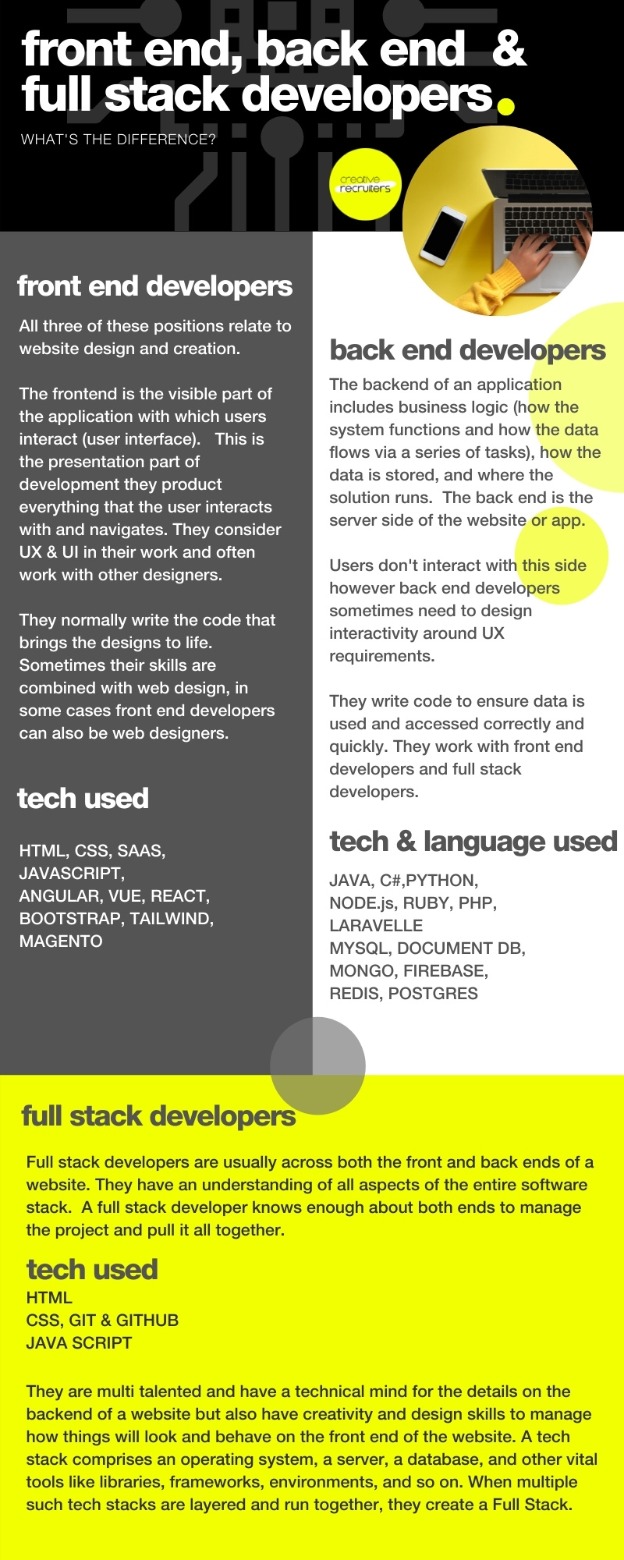Let’s break down just what is involved in these three important roles, all related to website and app development but each one is responsible for different tasks.
Front end
The domain of the front end developer is really the same as front of house at a hotel. It’s what the user sees and the parts of the website that they interact with. It’s the look and feel of the site that has been designed to capture the hearts and minds of consumers. The user features of a website are becoming more and more important and making a frictionless experience is the goal of all front end developers. This role evolves as technology evolves.
The skills required for this role are:
Collaboration
Creativity & design planning
Mapping
User experience (UX)
The front end developer writes code that brings the website to life for the user. They also work with various technologies to create interactive and user-driven tools such as calculators, surveys and forms. They translate UX & UI wireframes ( webpage planning documents) to code. They work on making websites beautiful and interesting and fit for purpose. They like bringing things to life and being a team focused person is very important in this role. Often working with clients and taking the idea and brief through to an appealing visual site is very rewarding for front end developers.
Back end
This title speaks for itself, it’s the person that looks after the back of house of the website. At the back of every site are databases, servers, applications and structures where the information is collected and stored and accessed. Some sites are more complex than others and some may have a team of back end developers constantly working away to ensure it’s operating smoothly. This role combines technology with programming skills.
The user never sees the work of the back end developer but they are essential in making the site function without issues and security and data breaches. They test, debug, backup and maintain the whole back end structure. This includes the core application logic, databases, data and application integration, API and other back end processes. So that the server, application, and database communicate with each other, back-end developers usually use languages like PHP, Ruby, .NET, Python, Java, and to build an application, and tools like Oracle, MySQL, and SQL to find, save, or change data and serve it to the user in front end code.
They work behind the scenes, with login authentication, calculating shopping carts, gathering personal information from a database or processing credit cards.
Full Stack
Developing front end website architecture is the realm of the full stack developer. Combining both front end and back end this role can handle both. Everyone’s experience varies and rarely is a person an expert at everything but often the full stack developer can understand the functionality of both integral roles and therefore makes an excellent project leader when it comes to web development.
The ‘stack’ can mean the full complement of technology or in the case of ‘native’ stack technology that exists just for one device eg; android, IOS or ‘mobile’ stack which is for app development and specifically development for viewing on mobile devices. They use HTML (HyperText Markup Language) and CSS ( Cascading Style Sheets) regularly to control elements on the page and control features including animations.
Below we have an infographic that will help clear up the differences between these roles, each of which is important in web development.
Creative Recruiters is Australia’s leading creative and digital recruitment agency. We specialise in creative roles, including front end development, and recruit Australia wide. Check out our job board for regularly posted opportunities or if you are a freelancer looking to be included in our freelance portal get in touch.


